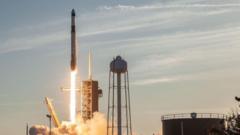The recent clash over a spending bill has amplified fears regarding NASA's funding, leading to proposed reductions that could severely compromise ongoing and future scientific missions. The space agency's budget request to Congress hints at a reduction of nearly half for its science funding, endangering more than 40 missions that are either launched or in development.
Experts in the field warn that such drastic budget cuts would have a "chilling impact" on the United States' human space exploration endeavors. Dr. Simeon Barber from the Open University expressed concerns that the current environment fosters uncertainty, undermining essential long-term planning that resides at the core of NASA's missions. He emphasized that cooperation among government, private companies, and academia is vital for successful space exploration.
In addition to the conflict between Trump and Musk, who heads SpaceX—NASA's key partner—the proposed budget cuts place nearly every area of NASA's operations under the knife, with the exception of the goals aimed at sending astronauts to Mars. Casey Dreier from the Planetary Society labeled these potential cuts as "the biggest crisis ever to face the US space programme."
NASA's budget request aims to streamline its focus toward missions deemed critical for lunar and Martian exploration. However, critics argue that this repurposing could diminish the agency's other crucial roles, including Earth observation and climate monitoring missions. Innovations in environmental health assessments might particularly suffer as funding dwindles.
The space community is apprehensive about the phasing out of investment in NASA's Space Launch System (SLS), which has been criticized for delays and exorbitant costs. Comparatively, SpaceX's reusable rockets, such as Starship, boast vastly lower launch costs. However, recent development challenges for these rockets raise doubts about their reliability.
Dr. Barber warned that if Musk's and Jeff Bezos's companies demand more funding, Congress may be placed in a compromised position. The current trajectory, he believes, risks dismantling decades of mission-critical work and vital planetary explorations.
Notably at risk are collaborative missions with the European Space Agency that include a plan to return Martian samples collected by NASA's Perseverance Rover and a mission focused on the search for past life on Mars. Those advocating for budget adjustments believe that this moment could present an opportunity for Europe to bolster its own space exploration capabilities, yet they acknowledge immediate concerns over reduced access to the International Space Station and the Lunar Gateway, a planned multinational space station.
The anticipated deep cuts could drastically affect climate monitoring programs, a crucial element in the fight against climate change. Experts caution that cutting these initiatives could compromise the ability to predict environmental impacts, a notion framed as a "frightening prospect."
With Congress yet to deliberate over the budget proposals, the cloud of uncertainty hangs over NASA's future. Dreier's assertion highlights a critical dilemma: political gridlock could stall the approval of any budget, perpetuating a cycle of funding at reduced levels, which may not be easily reversed. If missions are shuttered, the possibility of reactivation becomes almost impossible, leaving Earth’s space research and exploration in a precarious position.
Experts in the field warn that such drastic budget cuts would have a "chilling impact" on the United States' human space exploration endeavors. Dr. Simeon Barber from the Open University expressed concerns that the current environment fosters uncertainty, undermining essential long-term planning that resides at the core of NASA's missions. He emphasized that cooperation among government, private companies, and academia is vital for successful space exploration.
In addition to the conflict between Trump and Musk, who heads SpaceX—NASA's key partner—the proposed budget cuts place nearly every area of NASA's operations under the knife, with the exception of the goals aimed at sending astronauts to Mars. Casey Dreier from the Planetary Society labeled these potential cuts as "the biggest crisis ever to face the US space programme."
NASA's budget request aims to streamline its focus toward missions deemed critical for lunar and Martian exploration. However, critics argue that this repurposing could diminish the agency's other crucial roles, including Earth observation and climate monitoring missions. Innovations in environmental health assessments might particularly suffer as funding dwindles.
The space community is apprehensive about the phasing out of investment in NASA's Space Launch System (SLS), which has been criticized for delays and exorbitant costs. Comparatively, SpaceX's reusable rockets, such as Starship, boast vastly lower launch costs. However, recent development challenges for these rockets raise doubts about their reliability.
Dr. Barber warned that if Musk's and Jeff Bezos's companies demand more funding, Congress may be placed in a compromised position. The current trajectory, he believes, risks dismantling decades of mission-critical work and vital planetary explorations.
Notably at risk are collaborative missions with the European Space Agency that include a plan to return Martian samples collected by NASA's Perseverance Rover and a mission focused on the search for past life on Mars. Those advocating for budget adjustments believe that this moment could present an opportunity for Europe to bolster its own space exploration capabilities, yet they acknowledge immediate concerns over reduced access to the International Space Station and the Lunar Gateway, a planned multinational space station.
The anticipated deep cuts could drastically affect climate monitoring programs, a crucial element in the fight against climate change. Experts caution that cutting these initiatives could compromise the ability to predict environmental impacts, a notion framed as a "frightening prospect."
With Congress yet to deliberate over the budget proposals, the cloud of uncertainty hangs over NASA's future. Dreier's assertion highlights a critical dilemma: political gridlock could stall the approval of any budget, perpetuating a cycle of funding at reduced levels, which may not be easily reversed. If missions are shuttered, the possibility of reactivation becomes almost impossible, leaving Earth’s space research and exploration in a precarious position.





















